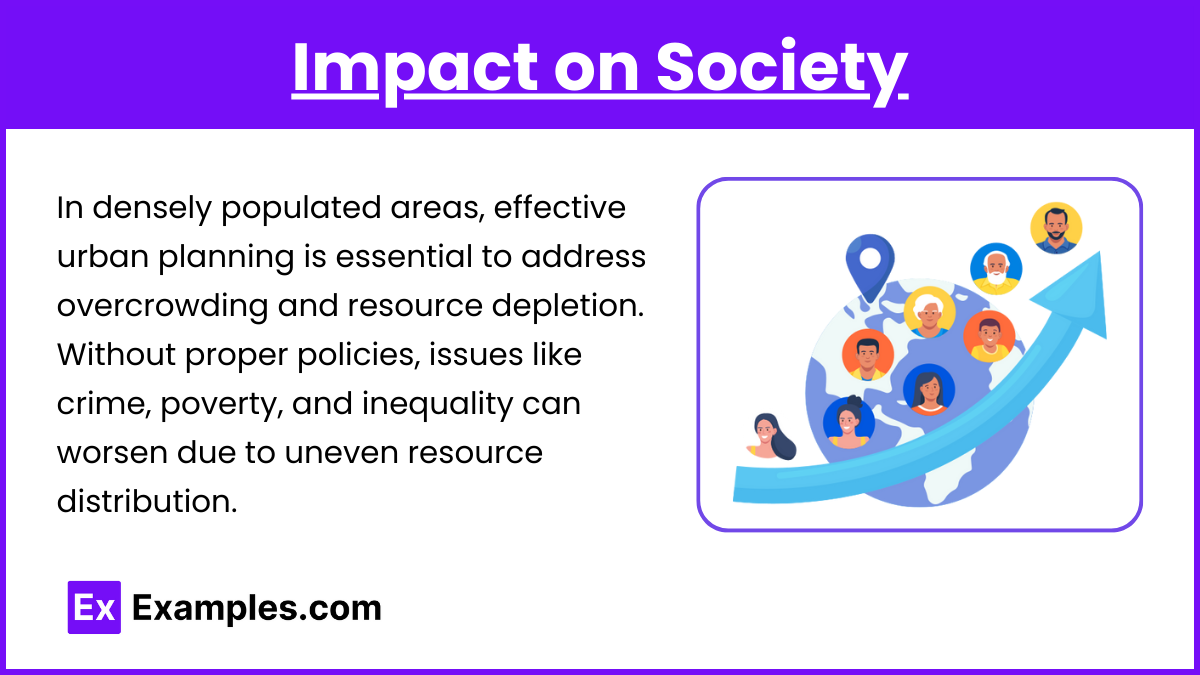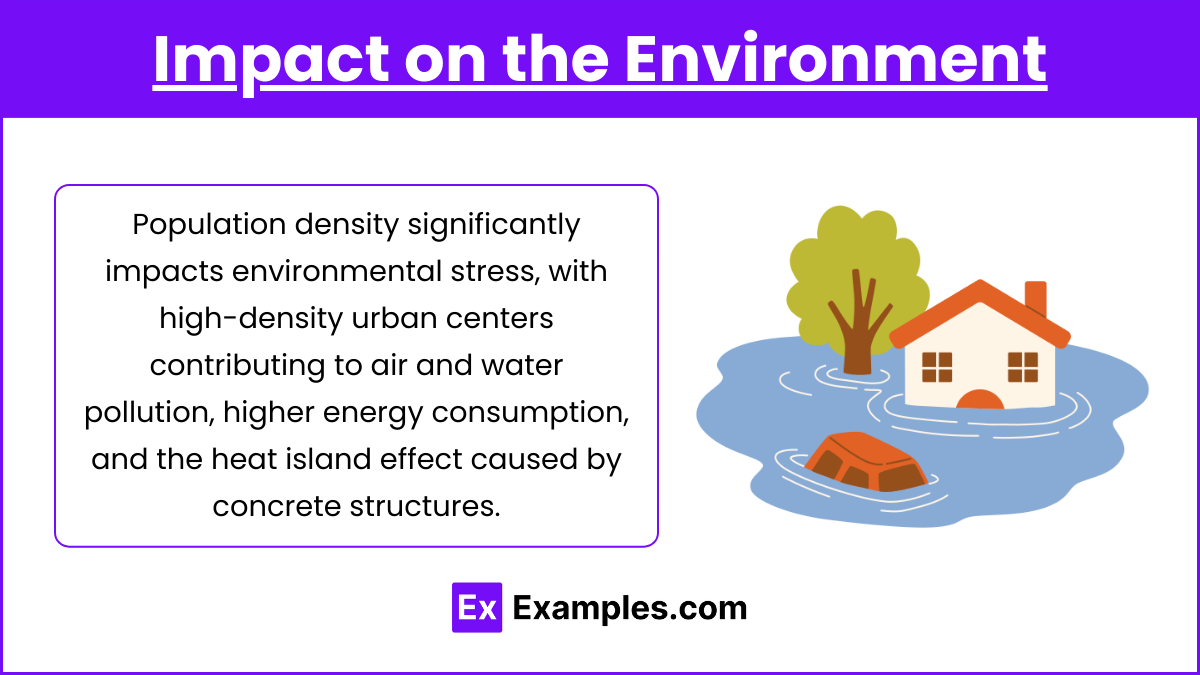In AP Human Geography, population density refers to the number of people living in a specific area and plays a crucial role in shaping both societal and environmental outcomes. In densely populated regions, pressures on housing, resources, and social services increase, leading to challenges such as overcrowding, pollution, and economic disparities. Conversely, sparsely populated areas may struggle with social isolation and limited access to services. Understanding population density is essential for analyzing human activities' impact on environmental sustainability, economic growth, and overall quality of life in various regions.
Free AP Human Geography Practice Test
Learning Objectives
For the topic "Population Density and How it Affects Society and the Environment" in AP Human Geography, you should aim to understand how different types of population density (arithmetic, physiological, and agricultural) influence social structures, economic development, and environmental sustainability. You should also explore the relationship between high and low population density areas and their effects on resource use, urbanization, pollution, and social services. Additionally, examine case studies that illustrate these dynamics and consider how population density impacts global and local environments and societies.
Population Density

Population density refers to the number of individuals living per unit of area, typically measured in people per square kilometer or mile. High and low population densities each have distinct effects on society and the environment. These impacts are shaped by factors such as urbanization, infrastructure, resource availability, and environmental sustainability.
Types of Population Density
Arithmetic Density: The total number of people divided by the total land area. It offers a basic overview but doesn’t account for differences in land use.
Physiological Density: The number of people supported by a unit of arable (farmable) land, indicating the potential pressure on land resources to produce food.
Agricultural Density: The ratio of the number of farmers to the total amount of arable land, revealing economic conditions and levels of agricultural productivity.
High Population Density

Social Effects: High-density areas, often found in urban regions, promote diverse economic opportunities and cultural exchange. These areas may experience stronger social cohesion due to frequent interactions, but also face challenges like overcrowding, strain on housing, education, and healthcare systems. Infrastructure must accommodate more people, leading to more efficient public transport and services, but it can also exacerbate inequalities, particularly in access to resources.
Environmental Effects: High population density often leads to increased pollution, habitat destruction, and the overuse of natural resources. Urban sprawl can encroach on ecosystems, contributing to loss of biodiversity. In densely populated areas, waste management and pollution control become critical environmental challenges. Moreover, cities tend to have a larger carbon footprint, contributing to global climate change.
Resource Strain: Food, water, and energy resources are stretched in densely populated areas. Sustainable development and resource management strategies must be employed to avoid overconsumption and environmental degradation.
Transportation: High-density areas typically see more reliance on public transportation systems, which can reduce per capita emissions but also create congestion and pollution if not properly managed.
Low Population Density
Social Effects: Rural areas with low population densities tend to have tighter-knit communities, but may face challenges related to economic development, as job opportunities and access to services are more limited. The cost of infrastructure per capita is higher, making it less efficient to provide widespread access to healthcare, education, and other essential services.
Environmental Effects: Low-density areas often have more natural landscapes and less immediate environmental degradation due to human activity. However, land use can be inefficient, leading to habitat fragmentation and ecological imbalances. Agriculture, deforestation, and the exploitation of natural resources can still impact biodiversity and contribute to environmental changes, such as soil erosion and deforestation.
Impact on Society

In densely populated regions, urban planning must be well-implemented to mitigate challenges like overcrowding and resource depletion. Social dynamics such as crime, poverty, and inequality can intensify in high-density areas if policies are not in place to support fair resource distribution. In contrast, in low-density areas, depopulation can lead to economic decline, with fewer available services, a shrinking workforce, and a diminished tax base, leading to deteriorating infrastructure and outmigration.
Example:
Tokyo, Japan, as one of the world's most densely populated cities, has implemented efficient urban planning strategies such as expansive public transportation systems, vertical housing developments, and green spaces to combat overcrowding. These measures help reduce the impact of high population density, but challenges like rising living costs and increased pressure on resources still persist.
Impact on the Environment

Population density is a key determinant of environmental stress. High-density urban centers contribute significantly to air and water pollution, energy consumption, and the heat island effect. Urbanization replaces natural ecosystems with concrete, leading to challenges such as stormwater management and increased flooding risks.
Conversely, while low-density regions may exert less direct environmental pressure, land-intensive activities such as agriculture, mining, or deforestation can still disrupt ecosystems and contribute to broader environmental issues, like climate change and biodiversity loss.
Example:
In New York City, high population density has caused air pollution and the heat island effect, necessitating large-scale stormwater management to prevent flooding. In contrast, the Amazon rainforest, a low-density region, faces deforestation due to agricultural expansion, contributing to biodiversity loss and increased global carbon emissions.
Examples
Example 1: Urbanization and Infrastructure in Tokyo, Japan
Tokyo is one of the most densely populated cities in the world, with over 37 million people living in the metropolitan area. The high population density has led to significant urban development, requiring efficient public transportation, waste management, and energy systems. The concentration of people fosters economic opportunities but creates challenges in maintaining affordable housing, controlling air pollution, and managing waste disposal. The city's vertical expansion (high-rise buildings) is an adaptation to limited land availability.
Example 2: Deforestation in the Amazon Rainforest
In Brazil, population pressures and the desire for agricultural expansion, especially in densely populated cities, have driven deforestation in the Amazon rainforest. As population density increases in urban areas, there is a rising demand for agricultural products, such as soybeans and beef, leading to clearing large forest areas. This deforestation not only harms biodiversity and carbon sequestration but also disrupts indigenous communities who depend on the forest ecosystem.
Example 3: Rural Depopulation and Services in Siberia, Russia
In contrast to urban areas, Siberia experiences low population density. This vast region has few inhabitants spread over large areas, leading to limited access to services like healthcare, education, and public transportation. The sparse population density slows economic development, and the lack of infrastructure can isolate communities, making it difficult for them to access basic services. However, this low density has helped preserve large swaths of wilderness and wildlife.
Example 4: Water Scarcity in Cairo, Egypt
Cairo, a megacity with a dense population, faces severe water scarcity due to population growth and increased demand for water. The city's location along the Nile River, combined with the rising number of people, places immense pressure on this limited water source. High population density leads to increased consumption, pollution of water sources, and challenges in managing water distribution. The scarcity affects agriculture, health, and the overall quality of life, forcing the government to consider desalination and other water-saving technologies.
Example 5: Traffic Congestion and Pollution in Los Angeles, USA
Los Angeles, known for its urban sprawl and dense population, suffers from severe traffic congestion and air pollution. The high population density, combined with a heavy reliance on automobiles, has led to chronic traffic jams and significant air quality problems. The reliance on cars contributes to greenhouse gas emissions and smog, impacting public health. City planners are working on public transportation expansion and green energy initiatives to alleviate these environmental and social issues.
Multiple Choice Questions
Question 1
Which of the following best describes the term "physiological population density"?
A) The number of people per unit of total land area.
B) The number of people per unit of arable land.
C) The number of people per unit of developed urban land.
D) The number of farmers per unit of arable land.
Answer: B) The number of people per unit of arable land.
Explanation: Physiological population density is a measure that shows the pressure people put on the productive land that can be used for farming (arable land). This type of population density provides insight into whether a country or region can support its population with the available resources. It’s different from arithmetic density, which calculates the number of people per total land area, whether the land is useful for agriculture or not.
Question 2
Which of the following environmental impacts is most commonly associated with high population density in urban areas?
A) Increase in biodiversity and green spaces.
B) Decrease in demand for resources like water and energy.
C) Higher levels of pollution and resource depletion.
D) Lower levels of urban sprawl.
Answer: C) Higher levels of pollution and resource depletion.
Explanation: High population density in urban areas often leads to environmental degradation, including increased pollution (air and water) and depletion of natural resources such as water, energy, and food. With more people in a limited space, there’s more waste production and greater use of resources, which can strain the environment. Urban sprawl tends to occur as cities expand, but within densely packed areas, the immediate effects are higher pollution and resource use.
Question 3
How does low population density in rural areas typically affect social services?
A) It improves access to healthcare and education services.
B) It leads to a wider variety of economic opportunities.
C) It can result in social isolation and limited access to services.
D) It increases the development of infrastructure and public transportation.
Answer: C) It can result in social isolation and limited access to services.
Explanation: In areas with low population density, such as rural regions, people often experience social isolation due to greater distances between communities. The provision of services like healthcare, education, and transportation becomes more challenging and expensive for governments, leading to limited access. This creates difficulties for the population, which may struggle with fewer job opportunities and inadequate public services compared to those in urban areas.


